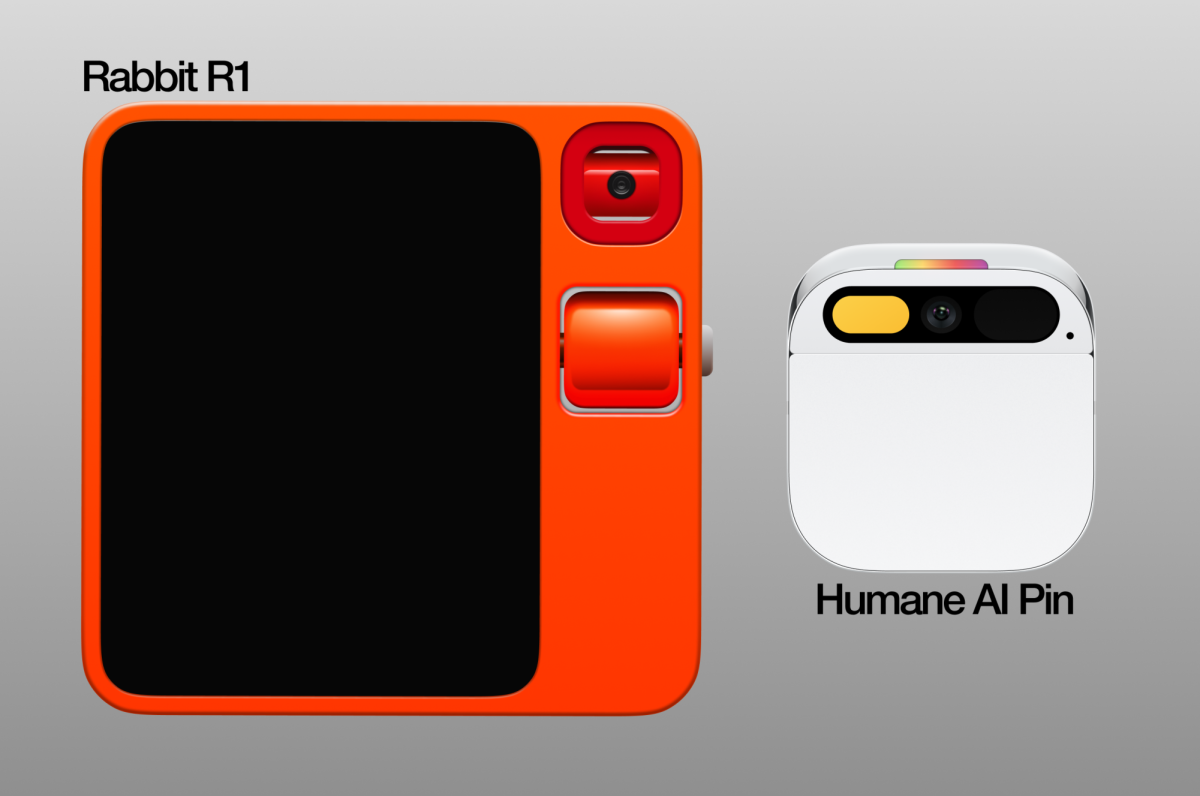AI is all anybody is talking about in the tech space right now. With ChatGPT and every website adding a snazzy AI-powered feature, AI has never gotten this much hype, and that hype has been building for a good reason. AI is transforming industries, revolutionizing how we interact with technology, and redefining what’s possible. It isn’t just about flashy features anymore; AI is becoming deeply ingrained in our daily lives, from personalized recommendations on streaming platforms to smart assistants managing our schedules.
The Humane AI Pin and the Rabbit R1 are just two examples of how AI is pushing boundaries and reshaping our expectations. They represent this shift towards more intuitive and user-friendly AI experiences, promising to simplify tasks and enhance productivity. As the tech landscape continues to evolve, the real winners will be anybody who can harness this power of AI to create meaningful solutions that resonate with users.
The Humane AI Pin presents itself as this revolutionary wearable device to replace your traditional smartphone with a screenless, AI-driven interface. Boasting a compact and well-built design, the AI Pin houses a range of features aimed at simplifying daily tasks. Utilizing an AI assistant and the proprietary operating system CosmOS, users can perform various functions such as making phone calls, sending text messages, calculating, note-taking, and accessing information via voice commands. Equipped with cellular connectivity, albeit limited to T-Mobile, and a network of AI models, the AI Pin strives to be an all-in-one solution for everyday digital interactions. Additionally, the device features a projector for displaying information and a touchpad interface for navigation. Despite its ambitious feature set, the AI Pin needs to improve its execution, with numerous reports of unreliable performance, slow responsiveness, and missing basic functionalities like setting alarms or adding calendar events. While the concept holds promise, the AI Pin’s current iteration leaves much to be desired in terms of functionality and user experience.
There are a few things that went wrong when people started using their AI Pins. Battery life was absolutely abysmal: the device is as small as an AirPods case which made it only last for about 2-3 hours, even with the attached magnetic battery booster that pins the device to your clothes only adding an extra 2 or so hours of battery life. This battery booster that is used to clip the device onto your clothing also gets uncomfortably warm even when not using it. Many reviewers talked about having a warm red patch of skin as a result of the battery. This overheating can cause the pin to become unresponsive and freeze; with the only way to reboot it being to take it off, place it on its charging dock, and use a paperclip to reboot the device.
It’s clear to me at least what Humane is trying to do here, when the AI Pin spits out an answer that is actually accurate quickly, it’s revolutionary feeling, but those moments are so few and far between, with most answers, it spits out being laughably and confidently wrong. It feels less like these early adopters got a first-generation product and more like they were forced to be beta testers.
The Rabbit R1 is another entry in this AI-in-a-box category, resembling the Humane AI Pin in many ways but also boasting its own distinctive features. Designed by Teenage Engineering, the compact device, about the size of a stack of Post-its, packs a built-in screen and a swiveling camera within a bright orange plastic enclosure. With a single button for queries and a scroll wheel for navigation, it responds to human commands, displaying results on-screen alongside this charming bouncing rabbit animation. Despite its modest $199 price tag, the Rabbit R1 aims to stand out with its “large action model,” a model that’s designed to understand and replicate human actions on applications, enabling it to perform more complex tasks on interfaces than a simple API would; essentially it reads applications and uses AI to map out these choices to make them easier to navigate.
There are a few fundamental differences between the Rabbit R1 and the Humane AI Pin. First the Rabbit R1 is $199 compared to the Humane AI Pin at $699. Second, the Rabbit R1 is also very bold in design, featuring an incredibly bright glossy orange color. Third, The R1’s operating system (Rabbit OS) has its “Large Action Model” (LAM). Unlike traditional AI assistants, Rabbit OS tries to serve as a “universal controller for various apps and services,” promising this seamless and intuitive user experience.
Essentially, Rabbit’s “Large Action Model” scans a website or app and simplifies the interface to make it easier to navigate. In reality, this is their way of competing with Apple’s large app store since it’s pretty likely that big companies aren’t rushing to develop a version of their app for the R1’s niche user base. But this “Large Action Model” barely works. As of May 2024 the Model only supports four services: Spotify, DoorDash, Uber, and Midjourney (AI Photo Generator). The biggest issue with this is the lack of real customizability, for example, trying to order DoorDash on the Rabbit R1 will only present you with 5 completely random menu items from the restaurant then after your order since it’s using its “revolutionary” Large Action Model, there’s no way for you to actually check when your food is coming, and asking it will prompt you to check the doordash app on your phone.
During the unveiling of the device, they also talked about bringing other services to the R1 using the Large Action Model like travel planning, where the R1 could create a travel plan and book all the necessary accommodations; this would certainly be awful. What if you had a specific seat on the airplane in mind? What if you need special accommodations? When does the Large Action Model consider that? Well… It doesn’t.
But to me, the Rabbit R1 feels like an even worse product. At least the Humane AI Pin innovates on the concept of integrating AI into your daily life by being a device that physically pins itself to your chest. The Rabbit R1 is just another handheld device that you have to carry around alongside your phone since it can’t do pretty essential phone things: call, text, navigation, etc. Boiled all the way down, the Rabbit is just ChatGPT baked into a cute portable box. So it begs the question, why isn’t this just an app? Well… It kind of is.
After the first batch of devices was sent out, people started snooping into the code itself. Reports emerged indicating that the device’s software may be based on Android, with leaked code revealing that the R1’s interface is essentially an Android app. This revelation raised concerns about the device’s originality and functionality, as it weakens the company’s claims of offering this unique and proprietary operating system. It makes sense that the Rabbit R1 isn’t completely original software and hardware. Why invest the years of research and development to create a kernel for managing device resources, then develop an operating system, and then implement an actual way to run applications, when you could simply use Android, which takes care of all of that and is widely used?
Nevertheless, most reviewers, since getting their R1s, pointed out this limited functionality, subpar performance, and questionable build quality. Issues like spotty Wi-Fi connectivity and laughably inaccurate responses from the R1 left many users feeling disappointed and frustrated. Tech reviewer, MKBHD reviewed both the Humane AI Pin and the Rabbit R1 and called both “barely reviewable.” Both of the devices releasing essentially half-baked under the guise of a “first-generation” product that would be frequently updated makes it hard to really grasp an opinion on them. Is it right to judge them by what their theoretical potential is, or is it better to judge them by what is currently shipping today?
This business model is surprisingly standard nowadays for tech. For a long time it used to be, make it, sell it, ship it. Now, tech has increasingly followed this model: pre-order it for full price, get it half-baked and wait for updates. For example, Tesla’s Cybertruck is still awaiting its Full Self-Driving Beta feature, years after Elon said that the truck would initially ship with it, leaving customers to wonder when they will finally receive the complete product they paid for. The Rabbit R1 and Humane’s AI Pin are just two recent examples of products struggling with this issue.
There’s also another elephant in the room. While these devices strive to replace your iPhone, it might not even be necessary. It’s being rumored that with the upcoming release of iOS 18 will come huge AI improvements, possibly powered by ChatGPT. These features might be implemented within Siri, where it would be able to smartly answer questions the way ChatGPT does, even display a pretty UI with useful information and complete actions like Rabbit R1 or the Humane AI Pin. Better yet, these features would actually run on the device that you use everyday, and wouldn’t be locked behind a $199 or $699 price tag. It’s likely that Apple’s implementation of this would be the first to introduce AI into the mainstream’s daily lives; their massive user base would certainly overshadow anything the Humane AI Pin or the Rabbit R1 could do.
Both Rabbit and Humane failed to meet the bar for quick and accurate responses to user inputs, as most people typically expect their intentions to be understood fully and addressed quickly; which is why Google has been the most used site since 2011. Their attempts at competing with your phone with glittering generalities of unsupported exaggerated claims were at best “cool in theory” and at worst e-waste, unable to even match the quickness or accuracy of even Google. As much as people like to believe smartphones are going away, soon to be replaced by something better, they’re not going anywhere. We are a long way ahead before they retire. This fast-lane-to-the-future belief just stems from boredom, since the tech world is always craving something new and inventive. Consumers might express this same boredom with smartphones too but that doesn’t mean they have any real intention of replacing them; and certainly not with a barely usable warm puck attached to their chest or with a bright orange half-baked meandering excuse for an Android device.












































